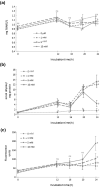An in vitro assay of the effect of lysine oxidation end-product, α-aminoadipic acid, on the redox status and gene expression in probiotic Lactobacillus reuteri PL503
- PMID: 34657206
- PMCID: PMC9117375
- DOI: 10.1007/s00726-021-03087-4
An in vitro assay of the effect of lysine oxidation end-product, α-aminoadipic acid, on the redox status and gene expression in probiotic Lactobacillus reuteri PL503
Abstract
This study was designed to gain information about the underlying mechanisms of the effects of a food-occurring free oxidized amino acid, α-aminoadipic acid (AAA), on the probiotic Lactobacillus reuteri PL503. This bacterium was incubated in colonic-simulated conditions (37 °C for 24 h in microaerophilic conditions) and exposed to three food-compatible AAA concentrations, namely, 1 mM, 5 mM, and 10 mM. A control group with no AAA exposure was also considered. Each of the four experimental conditions was replicated three times and samplings were collected at 12, 16, 20, and 24 h. The downregulation of the uspA gene by AAA (0.5-fold decrease as compared to control) suggests that AAA is identified as a potential chemical threat. The dhaT gene, implicated in the antioxidant defense, was found to be upregulated in bacteria treated with 1 and 5 mM AAA (up to twofold increase, as compared to control), which suggest the ability of the oxidized amino acid to impair the redox status of the bacterium. In fact, AAA caused an increased production of reactive oxygen species (ROS) and the accretion of post-translational changes (protein carbonylation) in L. reuteri (up to 13 nmol allysine/mg protein vs 1.8 nmol allysine/mg protein in control). These results suggest that probiotic bacteria identify oxidized amino acids as harmful species and activate mechanisms that may protect themselves and the host against their noxious effects.
Keywords: Oxidative stress; Oxidized amino acids; Probiotic bacterium; Protein oxidation; Transcripts.
© 2021. The Author(s).
Conflict of interest statement
The authors declare no conflict of interest.
Figures




Similar articles
-
Molecular mechanisms of the disturbance caused by malondialdehyde on probiotic Lactobacillus reuteri PL503.Microb Biotechnol. 2022 Feb;15(2):668-682. doi: 10.1111/1751-7915.13723. Epub 2020 Dec 23. Microb Biotechnol. 2022. PMID: 33356002 Free PMC article.
-
Resveratrol protects Lactobacillus reuteri against H2O2- induced oxidative stress and stimulates antioxidant defenses through upregulation of the dhaT gene.Free Radic Biol Med. 2019 May 1;135:38-45. doi: 10.1016/j.freeradbiomed.2019.02.023. Epub 2019 Feb 23. Free Radic Biol Med. 2019. PMID: 30807829
-
Noxious effects of selected food-occurring oxidized amino acids on differentiated CACO-2 intestinal human cells.Food Chem Toxicol. 2020 Oct;144:111650. doi: 10.1016/j.fct.2020.111650. Epub 2020 Aug 1. Food Chem Toxicol. 2020. PMID: 32745570
-
Next-Generation Probiotic Therapy to Protect the Intestines From Injury.Front Cell Infect Microbiol. 2022 Jun 28;12:863949. doi: 10.3389/fcimb.2022.863949. eCollection 2022. Front Cell Infect Microbiol. 2022. PMID: 35837474 Free PMC article. Review.
-
Metabolite 2-aminoadipic acid: implications for metabolic disorders and therapeutic opportunities.Front Pharmacol. 2025 May 13;16:1569020. doi: 10.3389/fphar.2025.1569020. eCollection 2025. Front Pharmacol. 2025. PMID: 40432896 Free PMC article. Review.
Cited by
-
Editorial.Amino Acids. 2022 Apr;54(4):481-484. doi: 10.1007/s00726-022-03164-2. Amino Acids. 2022. PMID: 35486192 Free PMC article. No abstract available.
-
Huoxiang Zhengqi decoction ameliorates gastrointestinal disorders induced by cold and humid environmental stress via modulation of intestinal mucosal microbiota and amino acid metabolism.3 Biotech. 2025 Jun;15(6):150. doi: 10.1007/s13205-025-04324-3. Epub 2025 May 3. 3 Biotech. 2025. PMID: 40331052
-
Gut Microbiota Combined with Metabolomics Reveal the Mechanisms of Sika Deer Antler Protein on Cisplatin-Induced Hepatorenal Injury in Mice.Molecules. 2023 Sep 6;28(18):6463. doi: 10.3390/molecules28186463. Molecules. 2023. PMID: 37764239 Free PMC article.
References
MeSH terms
Substances
Grants and funding
LinkOut - more resources
Full Text Sources

